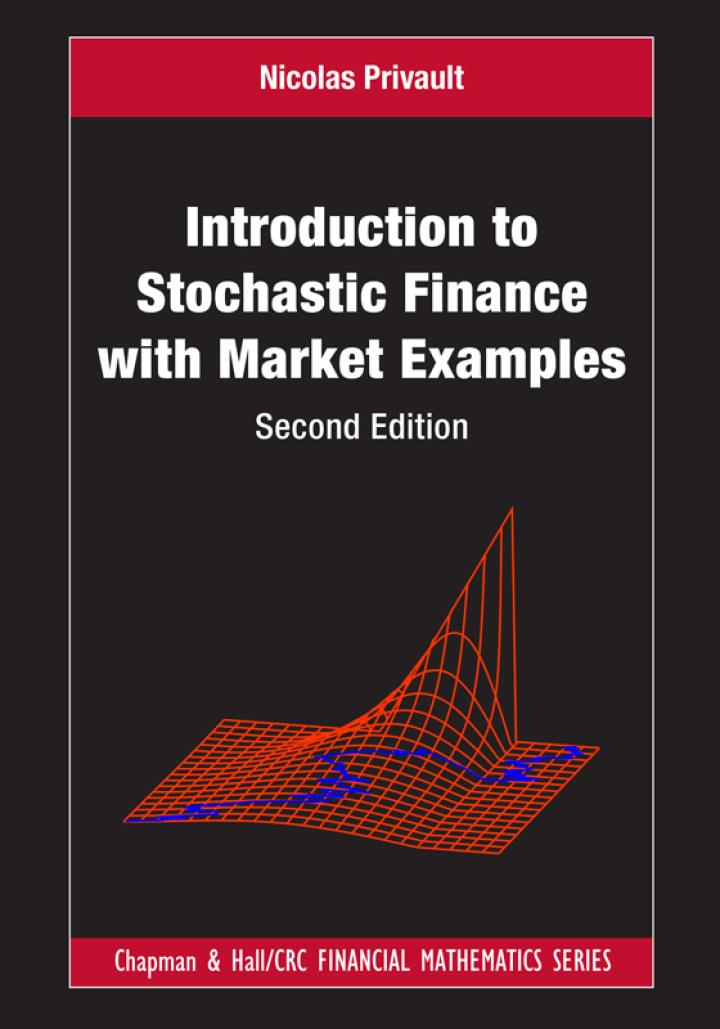Let (left(B_{t} ight)_{t in mathbb{R}_{+}})be a standard Brownian motion started at 0 under the riskneutral probability measure
Question:
Let \(\left(B_{t}\right)_{t \in \mathbb{R}_{+}}\)be a standard Brownian motion started at 0 under the riskneutral probability measure \(\mathbb{P}^{*}\). Consider a numéraire \(\left(N_{t}\right)_{t \in \mathbb{R}_{+}}\)given by
\[N_{t}:=N_{0} \mathrm{e}^{\eta B_{t}-\eta^{2} t / 2}, \quad t \geqslant 0\]
and a risky asset \(\left(X_{t}\right)_{t \in \mathbb{R}_{+}}\)given by
\[X_{t}:=X_{0} \mathrm{e}^{\sigma B_{t}-\sigma^{2} t / 2}, \quad t \geqslant 0\]
in a market with risk-free interest rate \(r=0\). Let \(\widehat{\mathbb{P}}\) denote the forward measure relative to the numéraire \(\left(N_{t}\right)_{t \in \mathbb{R}_{+}}\), under which the process \(\widehat{X}_{t}:=X_{t} / N_{t}\) of forward prices is known to be a martingale.
a) Using the Itô formula, compute \[\begin{aligned}
d \widehat{X}_{t} & =d\left(\frac{X_{t}}{N_{t}}\right) \\
& =\frac{X_{0}}{N_{0}} d\left(\mathrm{e}^{(\sigma-\eta) B_{t}-\left(\sigma^{2}-\eta^{2}\right) t / 2}\right)
\end{aligned}\]
b) Explain why the exchange option price \(\mathbb{E}^{*}\left[\left(X_{T}-\lambda N_{T}\right)^{+}\right]\)at time 0 has the BlackScholes form \[\begin{align*}
& \mathbb{E}^{*}\left[\left(X_{T}-\lambda N_{T}\right)^{+}\right] \tag{16.36}\\
&=X_{0} \Phi\left(\frac{\log \left(\widehat{X}_{0} / \lambda\right)}{\widehat{\sigma} \sqrt{T}}+\frac{\widehat{\sigma} \sqrt{T}}{2}\right)-\lambda N_{0} \Phi\left(\frac{\log \left(\widehat{X}_{0} / \lambda\right)}{\widehat{\sigma} \sqrt{T}}-\frac{\widehat{\sigma} \sqrt{T}}{2}\right) .
\end{align*}\]
Hints:
(i) Use the change of numéraire identity \[\mathbb{E}^{*}\left[\left(X_{T}-\lambda N_{T}\right)^{+}\right]=N_{0} \widehat{\mathbb{E}}\left[\left(\widehat{X}_{T}-\lambda\right)^{+}\right]\]
(ii) The forward price \(\widehat{X}_{t}\) is a martingale under the forward measure \(\widehat{\mathbb{P}}\) relative to the numéraire \(\left(N_{t}\right)_{t \in \mathbb{R}_{+}}\).
c) Give the value of \(\widehat{\sigma}\) in terms of \(\sigma\) and \(\eta\).
Step by Step Answer:

Introduction To Stochastic Finance With Market Examples
ISBN: 9781032288277
2nd Edition
Authors: Nicolas Privault





